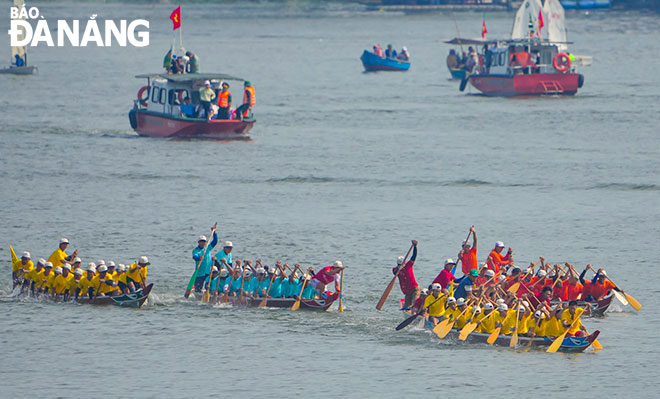Drivers of Da Nang's future economic growth
In the trend of recovery and strong development of tourism activities, the industry of arts, entertainment and recreation has increased their positive contributions to Da Nang's economy, in terms of contribution to GRDP growth, labour productivity and investment efficiency, and encouragingly, there is still much space for its development in the following years.
 |
| Here is a scene of the Da Nang Traditional Open Boat Race. Photo: HUYNH VAN TRUYEN |
Resolution No. 43-NQ/TW dated January 24, 2019 of the Politburo on building and developing Da Nang by 2030, with a vision towards 2045, sets the target of Da Nang's average GRDP growth rate of 12%/year in the period of 2021-2030.
Meanwhile, the Da Nang People's Committee has identified 6 key economic sectors that need more resources for recovery and development in the 2021 - 2025 period, namely accommodation and food services, transportation and warehousing, manufacturing and processing industry, information and communication, financial activities, insurance banking and real estate business activities.
There is a large contribution to the economy's GRDP growth, but in general, the effectiveness of Da Nang's key economic sectors is not commensurate.
Among the 8 economic sectors with the largest contribution to GRDP growth in 2022, information and communications and financial, banking and insurance activities that accounted for a total of 18.53% of the city’s GRDP in 2022 are 2 sectors with labour productivity and investment efficiency at very high levels.
They are followed by other industries that accounted for a large proportion such as manufacturing and processing industry, accommodation and food services, wholesale, retail, and car and motorbike repair.
Real estate business activities that accounted for a total of 37.3% of GRDP in 2022 are all experiencing low/very low labor productivity and investment efficiency.
In other words, Da Nang's current economic structure by industry can be a barrier for the city to improve the performance and competitiveness of its economy.
In contrast to the main economic sectors, the city's economy has a number of other sectors that have both high labour productivity and investment efficiency and they are consistent with the trend of shifting the in - depth growth model such as professional activities, science and technology; administrative operations and support services; arts, entertainment and recreation. Therefore, policy attention and development resource allocation also need to be directed towards these three sectors.
Accordingly, professional and scientific and technological activities are one of the few industries with a stable growth rate in the 2019 - 2022 period and labour productivity and investment efficiency achieved at a high level. This is also an industry that fits the development trend of the 4.0 industrial revolution and the need to transform the growth model in depth of the city's economy.
In a similar vein, in the trend of recovery and strong development of tourism activities; arts, entertainment and recreation is an industry that is increasingly making a positive contribution to Da Nang's economy and there is still much space for development in the following years.
Besides, the development of this industry is also consistent with the need to improve competitiveness and added value in Da Nang's current tourism sector. In fact, experiencing developing tourism services at famous destinations around the world shows that there is a trend of reducing the proportion of spending on basic services such as travel, accommodation and meals and increasing that on arts, entertainment and recreation activities. In other words, this industry needs to receive more development investment sources in Da Nang.
With the above-mentioned analysis results, it is high time for Da Nang to have an appropriate perspective on enhancing the role of economic sectors in the new economic development requirements.
Firstly, as for industries with a large proportion of added value and/or capital/labour intensive such as accommodation and food services, manufacturing and processing industries, wholesale and retail, and automobile repair, motorbikes and motorbikes, improving investment efficiency, labour productivity and competitiveness is a key goal.
Secondly, with regard to industries that both contribute greatly to the GRDP growth and have great performance such as information and communications, financial activities, banking and insurance, it is necessary to create conditions for increasing the proportion of added value of these industries in GRDP.
Thirdly, when it comes to industries that are consistent with development trends and actively support the transformation of new in-depth growth models such as education and training, professional activities, science and technology, arts, entertainment and recreation, it is a must-do to prioritise increasing investment capital and gradually expanding the scale of added value effectively.
Regarding development resources, resolving bottlenecks and unlocking the economy's limited resources should be identified as goals not only for 2023 but also for the entire upcoming period.
Reporting by LE THI HONG CAM - Translating by A.THU








